Flight into Egypt
Flight into Egypt
– Sister M. Danielle Peters
The following information about the Journey of the Holy Family to Egypt has been compiled from various Eastern and Western resources, predominantly the Apocryphal Gospels of Pseudo Matthew and St. Thomas, as well as from the Arabic and Armenian Infancy Gospels. Moreover, the Vision of Theophilus by the twenty-third Patriarch of Alexandria from the fourth century as well as the Homily of Zachariah, Bishop of Sakha, seventh century were consulted. Finally, we have made use of the Coptic and Ethiopic Synaxaria (calendar of the saints) and several Muslim traditions.
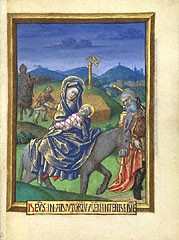
It has proven to be rather challenging to present the reader with authentic information about first-century Egypt since most traditions relating to the Holy Family’s Flight to Egypt were rendered between the tenth and thirteenth centuries.
For more information we recommend the very comprehensive and invaluable study The Holy Family in Egypt by Otto F.A. Meinardus, The American University in Cairo Press 1986.
OLD TESTAMENT PROPHECIES
The Infancy narratives of the New Testament record the fulfillment of the Old Testament prophecies as they unfold in their historical sequence.
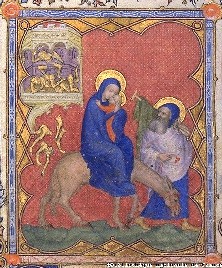
Jesus Christ was born in Bethlehem as prophesied by the prophet Micah:
- “But you, Bethlehem-Ephrathah too small to be among the clans of Judah, from you shall come forth for me one who is to be ruler in Israel; whose origin is from of old, from ancient times.” (5:1)
- The slaughter of the innocent children had been foretold by Jeremiah:
- “Thus says the Lord: In Ramah is heard the sound of moaning, of bitter weeping! Rachel mourns her children, she refuses to be consoled because her children are no more.” (31:15)
- The prophet Isaiah provides us with a prediction of the effect the holy Infant was to have on Egypt and the Egyptians:
- “Oracle on Egypt: See, the Lord is riding on a swift cloud on his way to Egypt; the idols of Egypt tremble before him, the hearts of the Egyptians melt within them. On that day there shall be an altar to the Lord in the land of Egypt, and a sacred pillar to the Lord near the boundary.” (19:1.19f)
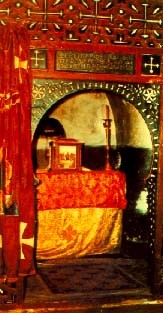
According to the traditions of the Coptic Church, ‘the altar’ mentioned is that of the Church of Mary in Al-Muharraq Monastery, a site where the Holy Family is believed to have settled for a period of more than six months; and the altar-stone was the bed, upon which the Infant Savior lay.
Al-Muharraq Monastery is located, literally, in the midst of the land of Egypt standing at its exact geographical center.
THE GOSPEL ACCORDING TO ST. MATTHEW
The flight of the Holy Family to Egypt, seeking refuge, is an event related to us very briefly in the Gospel of St. Matthew.
Behold, the angel of the Lord appeared to Joseph in a dream and said,
"Rise, take the child and his mother, flee to Egypt, and stay there until I tell you. Herod is going to search for the child to destroy him." (2:13)
Joseph complied. It might have taken the fugitives three days to reach Egypt where they were beyond Herod’s jurisdiction. Of the flight, and its duration, Scripture gives us no further information, telling us only that the Holy Family fled by night from Bethlehem, and returned when Joseph had again been assured in a dream that it would be safe to take the Savior back to the land of His nativity.
Apocryphal Sources
St. Matthew tells us neither where the Holy Family abode in Egypt, nor how long their exile lasted; the Evangelist alludes only to the causes of their flight and of their return. Ancient legends relate that they remained absent two years from Palestine, and lived at Matareya, a few miles northeast of Cairo, where a fountain and a Sycamore tree under which they had rested emerged upon Jesus’ request.
It is left to apocryphal legends, immortalized by the genius of Italian art, to tell us how, on the way, the dragons came and bowed to Him, the lions and leopards adored Him, the roses of Jericho blossomed wherever His footsteps trod, the palm-trees at His command bent down to give them dates, the robbers were overawed by His majesty, and the journey was miraculously shortened. They tell us further how, at Jesus’ entrance into the country, all the idols of the land of Egypt fell from their pedestals with a sudden crash, and lay shattered and broken upon their faces, and how many wonderful cures of leprosy and relief of demoniac possession were accomplished by His word. This wealth of legendary miracles arising in part from a mere craving for the supernatural, and in part from a fanciful application of Old Testament prophesies - furnishes a strong contrast to the truthful simplicity of the Gospel narrative.
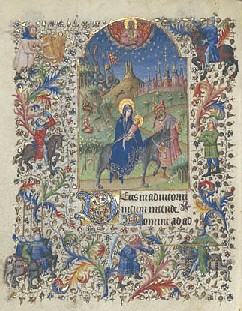
THE WAY TO EGYPT
There were three routes available to travelers traversing Sinai from Palestine to Egypt, a crossing, which was usually undertaken in groups for mutual protection and security. However, in their escape from the infanticide fury of King Herod, the Holy Family had to avoid those tracks and to pursue less known paths.
The tortuous trails they followed in their passage across Sinai, and their subsequent travels within Egypt, are chronicled by Theophilus, twenty-third Patriarch of Alexandria (384 – 412 A.D). He testifies that on the eve of the sixth of Hator (the Coptic month corresponding roughly with November), after long prayer, the Holy Virgin revealed herself to him and, after relating the details of the Holy Family’s journey to, in, and from Egypt, asked him to record what he had seen and heard.
The Journey
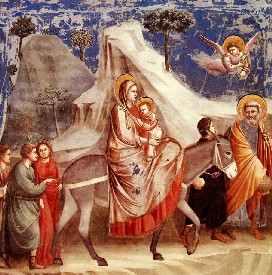
According to the apocryphal Infancy Gospel of James, the Holy Family fled together with Salome, Mary’s midwife. They made their way through the Judaic desert to the Jordan valley. The majority of images show the procession traversing from left to right. The opposite direction indicates the return of the Holy Family to The Holy Land.
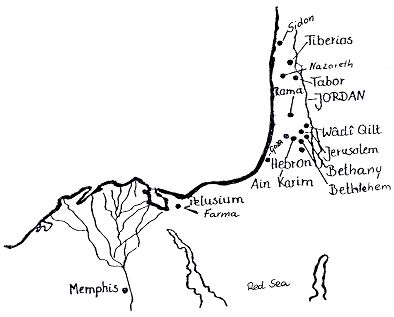
Sources of the Coptic Church tell us that the Holy Family proceeded from Bethlehem to Gaza, then to El-Zaraniq (also known as Floussiat), some twenty-eight miles west of al-Arish, near the oasis of Ain Hagla close to the Jordan River, orthodox monks have named their church in honor of the Holy Family. For them it marks the place where the Holy Family had their first rest.
Subsequently, Ain Hagla was surnamed Kalamonia, which means ‘good abode.’
Next, they threaded their way along northern Sinai until they reached Farma (ancient Pelusium) mid – way between al-Arish and present-day Port Said. The Greek monk Epiphanius Hagiopolites (eighth century) as well as the Western monk Bernard the Wise (870 AD) mention in their writings that the Holy Family stopped in this city. The local church dedicated to Mary commemorates the Angel’s message to Joseph to leave for Egypt.
They then traveled east to the ancient city of Hebron, reputedly one of the oldest cities of the world and a holy site for Jews, Christians and Muslims since here in the cave of Machpelah Abraham and Sara, Isaac and Rebecca as well as Jacob and Lea found their last resting place.
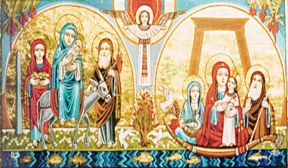
“Intercede for me with Ephron, son of Zohar, asking him to sell me the cave of Machpelah that he owns; it is at the edge of his field. Let him sell it to me in your presence at its full price, for a burial place." (Genesis 23:9)
The apocryphal Armenian infancy narrative reports that the Holy Family continued their journey to Ashkelon where Samson had slaughtered thirty Philistines,
“The spirit of the Lord came upon him, and he went down to Ashkelon, where he killed thirty of their men and despoiled them; he gave their garments to those who had answered the riddle.” (Judges 14:19)
On the twenty-fourth day of the Coptic month of Bashans, which corresponds to the first of June, the Coptic Church celebrates the entry of the Lord Jesus Christ into the Land of Egypt. On that day, the churches throughout the land pray in the words of the Doxology:
"Rejoice, Oh Egypt; O, people of Egypt and all ye Children of Egypt who live within its borders, rejoice and lift up your hearts, for the lover of all mankind, He who has been before the beginning of ages, has come to you".
THE ROUTE OF THE HOLY FAMILY IN EGYPT
As we trace the steps of the Holy Family in Egypt we will refer to this map by including the numbers referring to the thirty places associated with the flight.
map of their route in Egypt
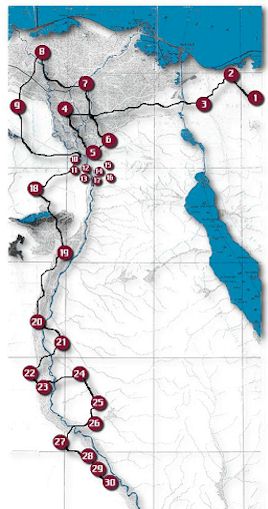
1. Rafah
2. Al-Arish
3. Farma
4. Tal Basta
5. Mostorod
6. Belbeis
7. Meniet Samanoud
8. Sakha
9. Wadi El-Natroun
10. Ain Shams
11. Matareya
12. Zeitoun
13. Zeweila Alley
14. El-Ezbaweya
15. The area of Old Cairo
16. Babylon
17. Maady
18. Ashnein: El-Nasara & El-Garnous Monastery
19. Bahnassa
20. Samalout
21. Gabal al Tair
22. Hermapolis: Al-Ashmounein Town - Mallawy
23. Daurout Um Makhla
24. Beer El-Sahaba
25. Kom Maria
26. Tal El-Amarna
27. Daurout
28. Qoussia
29. Meir
30. Monastery Of Moharraq
In the Nile Deltat
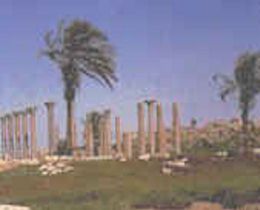
Various traditions relate that the Holy Family discovered many springs and wells in the area of the Nile delta and valley. Moreover, in many villages we find mention of a certain palm tree, which not only offered shade to the Holy Family but nourished them with its fruit as well.
During the years 7 and 4 BC while Gaius Turranius was governor in Egypt, the Holy Family crossed the narrow Isthmus of al Qantara on which already Abraham (Gen 12:10), Jacob and his sons traveled into Egypt.
Tal Basta
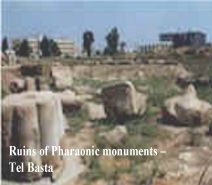
The Coptic Synaxar (calendar of the saints) records Tal Basta (4) - about seventy-two miles northeast of Cairo - as the first Egyptian town visited by the Holy Family. According to the vision of Coptic patriarch Theophilus (384-412), the Holy Family was attacked here by two robbers. Disappointed by this experience, they quickly continued their journey towards Belbeis (6).
Another tradition relates that in Tal-Basta - or Basta – (4) Jesus caused a spring to well up from the ground, and His presence triggered the idols to crumble, as foretold by the prophets of old. The townsfolk, in consequence, turned malevolent and aggressive, whereupon the Holy Family turned their backs on the town and headed southwards.
Mostorod
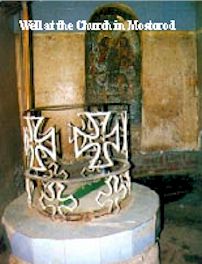
In due course, they reached Mostorod (5) (which later received the name Al-Mahmma) only about seven miles north west of Cairo. ‘Al-Mahmma’ means ‘the Bathing place’ a name given to the town because the Virgin Mary bathed the Christ Child and washed His clothes there. It is worthy of note that, eventually, on their way back to Palestine, the Holy Family stopped once more at Mostorod and, this time, caused a spring to gush from the earth, which still flows forth to the present day.
Belbeis
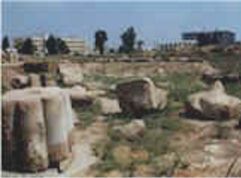
Their flight continued to Belbeis (6). Here we have an example of a Mary Tree around which the local citizens have arranged their cemetery. This tree was removed in 1850. In Belbeis Muslims commemorate the visit of the Holy Family in the Osman El-Haress El-Ansari Mosque and at the corner of Al-Ansârî Street.
Meniet Samanoud, Sakha, Burullus
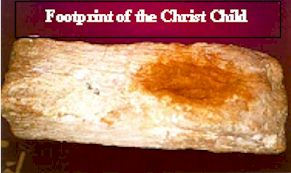
The journey continued north to Meniet Samanoud (7) where the local population received them with a kindness and hospitality that earned them a deserved blessing. A large granite trough that, according to local belief, was used by the Virgin for kneading dough, and a water-well, which the Christ Child, Himself, blessed, can still be seen today.
footprint of the Christ child
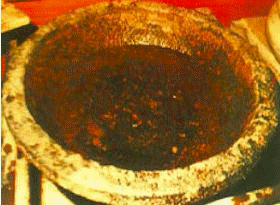
According to a homily of Bishop Zacharias of Sakhâ (seventh c), the Holy Family traveled from Samanoud to Burullus via Sakha (8) where according to tradition Jesus left his footprint on a rock. For this reason, this place is called Bikha Isus (‘Pekha–Issous’, vernacularized to Lysous) or Footprint of Jesus. The rock was preserved, but hidden for centuries for fear of robbery, and only unearthed again in 1984. Their trail from Sakha is recorded in the documentation of Pope Theophilus’ vision, and attested to by Coptic practice in the Christian era.
Wadi el-Natroun
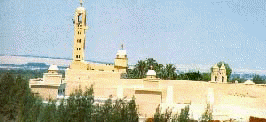
Next they arrived at Wadi El-Natroun (9) (Natroun Valley) after crossing the Rosetta branch of the Nile to the western Delta, and heading south into Wadi El-Natroun (then called Al Asqeet) in the Western Desert of Egypt.
In the earliest decades of Christianity, the desert expanses of Wadi El-Natroun became the site of anchoretic settlement and, later, of many monasteries. It is said that Jesus blessed the desert in view of these future settlements. In 1986 there were about 320 monks occupying the four Wadi ‘n-Natrun monasteries.
In the Nile Valley
Eventually, they left the desert behind them and made their way southwards crossing the Nile to its eastern bank, and heading for Matareyah (11) and Ain Shams (10), the ancient Heliopolis and the site of the oldest ‘university’ in history called since earliest pharaonic times, ‘On’ see Jeremiah 43:13. Both these adjacent districts are outlying suburbs of present-day Cairo, only seven miles from the city center.
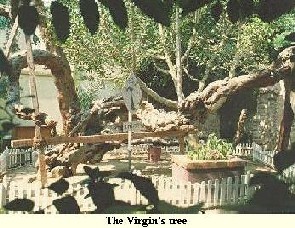
It seems reasonable that the Holy Family would have wanted to avoid pagan areas and looked for places of Jewish settlements. Historical sources reveal the Holy Family’s stay at Matareyah. The apocryphal gospel of Pseudo-Matthew, the Coptic and Egyptian synaxar as well as stories of Holy Land visitors during the Middle Ages relate details of the Holy Family at this place.
In Matareyah, a tree stands to this day, still regularly visited, called ‘Mary's Tree’, for the Family is believed to have rested in its shade. Here, too, the Infant Jesus caused water to flow from a spring. He blessed it, drank from it and Mary washed His clothes in it. She poured the washing water onto the ground, and from that spot, a fragrant balsam plant blossomed. Besides the healing and pain-soothing properties of this balm, its essence is used in the preparation of the scents and perfumes of which the holy Chrism is composed.
Cairo
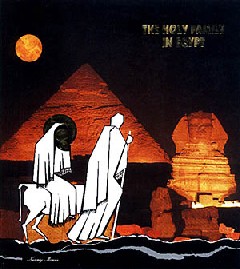
Continuing their way southwards, the Holy family passed the Fortress of Babylon (Old Cairo, 15) and saw the pyramids of Giza. According to tradition there used to be a palm tree at Giza under which the Blessed Virgin Mary nursed Baby Jesus. This palm tree was allegedly the only tree in the region bearing fruit.
Maddy
Next, the Holy Family moved south, reaching the modern Cairo suburb of Maady (17), which, in earliest pharaonic times, was an outlying district of Memphis, the capital of Egypt at that time.
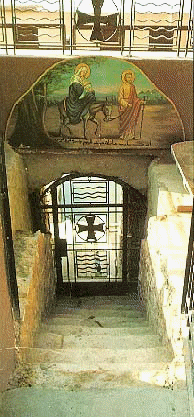
Joseph became acquainted with the sailors of the Nile boats and the Holy Family was invited to be taken south to Upper Egypt. The monks of the Dair al-Muharraq (The Monastery of the Blessed Virgin) assume that the Holy Family could afford the travels because of the gold they received from the Wise Men of the East (Mt. 2:11).
The historic church built upon the spot from which they embarked, also dedicated to the Blessed Mother, is further identified by the denominative, ‘Al-Adaweya’, the Virgin’s Church ‘of the Ferry’. (In fact, the name of that now modern suburb, Maady, derives from the Arabic word, which means ‘the crossing point’).
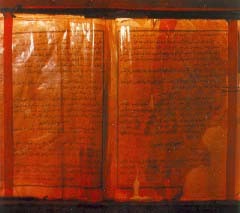
The stone steps leading down to the River’s bank, and believed to have been used by the Holy Family are accessible to pilgrims through the Church courtyard.
An event of miraculous import occurred on Friday the third of the Coptic month of Baramhat - the twelfth of March - 1976 A.D. A Holy Bible of unknown origin was carried by the lapping ripples of the Nile to the bank below the Church. It was open to the page of Isaiah 19: 25 declaring:
"Blessed be Egypt My People"
The Bible is now behind glass in the Sanctuary of the Church for all to see.
Deir El-Garnous and of Ashnein El Nassara
A well at El-Garnous Monastery
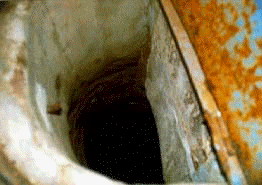
The sailboat docked at the village of Deir El-Garnous (the later site of the Monastery of Arganos) four miles west of Ashnein El Nassara (18). Outside the western wall of the Church dedicated to the Blessed Virgin Mary, a deep well is believed to have provided the Holy Family with the water they needed.
In commemoration of the blessings the village received through the visit of the Holy Family the people celebrate an annual fair, called mulid, on August 21 and 22. During the fair it is said that no one has ever been bitten by vermin.
Approximately five thousand people attend this fair and enjoy the water from the well.
Al Bahnassa and Samalout
They went on from there to a spot later named Abai Issous, "the Home of Jesus", the site of present-day Sandafa village, east of Al Bahnassa (19) which stands some thirteen miles west of the town of Beni Mazar.
Muhammad al Baqir (676-731 AD) relates that the nine-months-old Jesus attended the school at Al Bahnassa. “The teacher said to Jesus: “Say the alphabet.” Jesus lifted up his head and said: “Dost thou know what these words mean?” The teacher wished to strike him, but Jesus said: “Do not strike me, but if thou dost not know, ask me and I shall explain to thee.” “Speak,” said the teacher. “Come down from thy desk,” answered Jesus. The teacher came down and Jesus took his place and began to say: “The Alif stands for the good deeds of God, Da for the glory of God, the Gim for the splendor of God, the Dal for the religion of God, the Ha for the abyss of hell, the Wa indicates the misery of those living in hell, the Ha means the remission of sins of those who ask for forgiveness, the K is the word of God which will never change, the Sad is the measure for a measure, the Ta stands for the serpents of hell.” “Well,” said the teacher to the Blessed Virgin, “take thy Son and watch over Him for God hath given to Him wisdom and He doth not need a teacher.” This tradition should be compared with the almost identical story in the Gospel of St. Thomas the Israelite (140 – 160 AD).”[1]
[1] Meinardus, Otto F.A. The Holy Family in Egypt, The American University in Cairo Press, 1986, p 45
On towards the south they went from Bahnassa to Samalout (20) and crossed the Nile again from that town to the spot on the east bank of the River where the Monastery of the Virgin now stands upon Gabal Al-Tair (‘Bird Mountain’ 21) east of Samalout, and south of Meadeyat Beni Khaled. The Holy Family rested in the cave which is now located inside the ancient Church there. Gabal Al-Tair is also called Gabal El-kaf (Palm Mountain).
Coptic tradition maintains that, as the Holy Family rested in the shade of the mountain, Jesus stretched His little hand to hold back a rock which was about to detach itself from the mountain side and fall upon them, the imprint of His palm is still visible.
When they resumed their travels, the Holy Family passed a laurel tree a stone’s throw south of Gabal El-Tair, along the pathway flanking the Nile and leading from the mountain to Nazlet-Ebeid and the New Minia Bridge of today. It is claimed that this tree bowed to worship the Lord Christ as He was passing. The configuration of the tree is, indeed, unique. All its branches incline downwards, trailing on the ground, and then turn upwards again, covered in a cloak of green leaves. They call the tree Al-Abed "The Worshipper."
CROSSING THE NILE
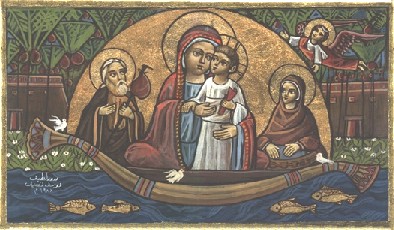
Al-Ashmounein, Qussqam, Meir
Once more crossing the Nile, back to its west bank, the Holy Family traveled southwards to the town of Al-Ashmounein (22) or Harmopolis Magna, but it seems that they did not tarry long there. Leaving behind them the rubble of fallen idols, they continued to Dairout Al-Sharif (which, like Al-Ashmounein had an alternative Greek name, Philes), and thence to Qussqam (28) (or Qost-Qoussia).
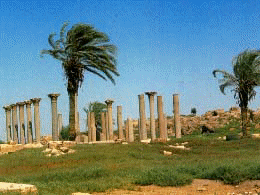
Here, too, the recorded events testify that the townsfolk were infuriated when the stone statue of their local deity cracked and fell, and evicted the Holy Family from the town. A historically recorded incident dating to that period refers to the devastation of Qussqam, and Coptic tradition asserts that the ruin that befell the town was the consequence of its violent rejection of the gentle visitors.
There exists an entirely different story in the warm welcome with which the holy refugees were met at their next stop at Meir (29) (or Meira) only seven miles west of Qoussia. Here, they found hospitality wherever they went, for which the town and its people were abundantly blessed. And again another story relates that the two robbers who earlier had attacked the Holy Family and since then had followed them closely assaulted them again here with sword and covered faces. They demanded the garments of Jesus, Mary and Joseph and even tore the veil off Mary’s head.
One of the thieves who saw that Mary wept felt remorse and intended to return the clothes to them. After Jesus had put his clothes on again, he told his mother: “Mary, I will be crucified in Jerusalem and these two thieves will be crucified with me. The thief who just returned our clothes will realize who I am and believe in me. He will be the first one to be in paradise even before Adam and his descendants.”
Now it was time for the Holy Family to set out for what is arguably the most meaningful destination of all in the land of Egypt, the place where there would be "an altar to the Lord in the midst of the land of Egypt", Gabal (Mount) Qussqam. The Monastery of Al-Moharraq was built around the area where the Holy Family remained just over six months. Their time was spent mainly in a cave, which became, in the Coptic era, the altar of the Church of Virgin Mary and the altar stone supposedly was the resting place of the Child Jesus during the months He dwelt there.
Sometimes this place is referred to as the Second Bethlehem. It is believed that at the very spot where Al-Moharraq Monastery stands, the Angel of the Lord appeared to Joseph in a dream, and said
"Arise, and take the young Child and His mother, and go into the land of
Israel; for they are dead which sought the young Child’s life." (Mt.2:20)
Tradition relates that the church dedicated to the Blessed Virgin Mary in Dair al-Moharraq was the first church built in Egypt. It is believed that it was built immediately after St. Mark’s arrival in Egypt around 60 AD.
THE RETURN TO PALESTINE
The return route they took deviated slightly from the one by which they had come. It took them to the city of Assiut, and their blessing of this location was commemorated in the Christian era by the building of the mountaintop convent of the Virgin Mary.
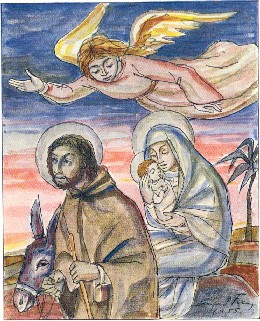
Eventually, they arrived at Old Cairo, then Matareyah, and on to Mahamma, retracing more or less their steps on their outward journey across Sinai to Palestine. Matareyah has made international headlines in recent times when on April 2, 1968 an apparition of Mary above the cupola of St. Mary Church in Zeitoun (12) was witnessed by thousands of Christians and Muslims, Egyptians and Europeans alike.
From Matareyah the Holy Family traveled to Mahammah where the temple was destroyed as they approached it. A well at Mahammah still commemorates the bath Mary and Joseph took there.
From there the way led via Belbeis (6) through Wadi Tumilat to the same route on which they came to Egypt.
CONCLUSION
Subsequent Biblical history says it all: at the end, they arrived home, Joseph’s old house, in the small town of Nazareth, in Galilee, in the land of Palestine, from where the message of Christ would in the fullness of time, be heard.
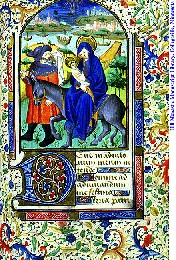
It is estimated that the whole journey from Bethlehem to the return to Nazareth lasted over three years.
They had covered approximately 1242.80 miles. Their means of transport was a weak beast of burden and the occasional sailboat on the Nile. But for much of the way, they must have trudged on foot, enduring the fierce summer heat and the biting winter’s cold, suffering the pangs of hunger and the parching affliction of thirst. It was a journey of much deprivation, which the Child Jesus, His Virgin Mother and Saint Joseph endured in view of their divine mission.
Images shown:
Vittore Carpaccio, c. 1465-1526, The Flight Into Egypt
Georges Trubert, Provence, about 1480-1490.
John of Berry's Petites Heures, France, Paris, fourteenth Century. (90 x 70 mm)
Master of Jean Rolin II, French 1455.
Coptic Logo Icon, see: http://pharos.bu.edu/cn/exhibits/Pictures.html#icons
Coptic Art, see: www.egyptvoyager.com/
Marian Library Archives
All About Mary includes a variety of content, much of which reflects the expertise, interpretations and opinions of the individual authors and not necessarily of the Marian Library or the University of Dayton. Please share feedback or suggestions with marianlibrary@udayton.edu.
